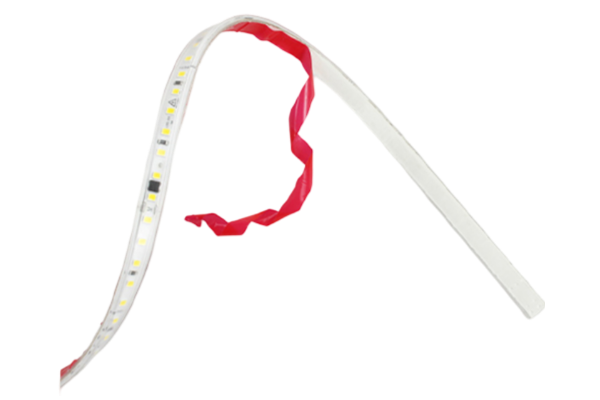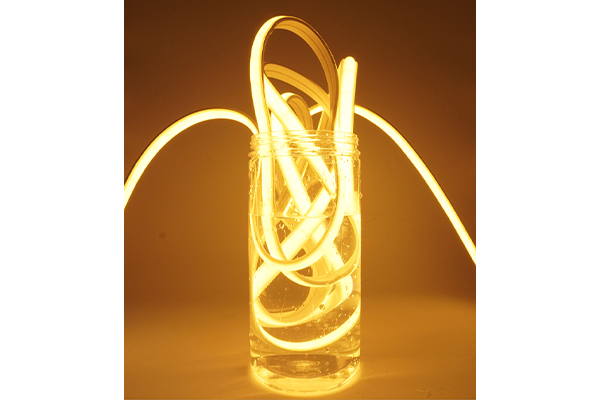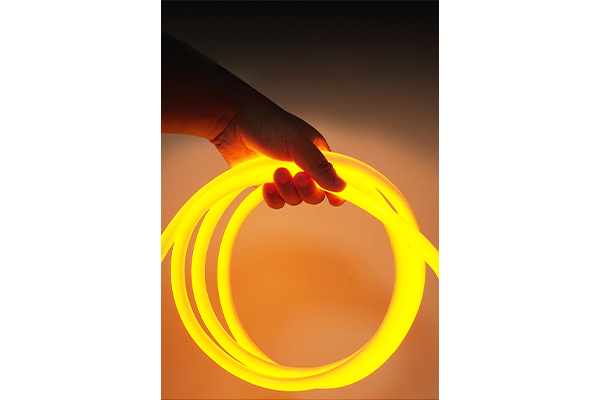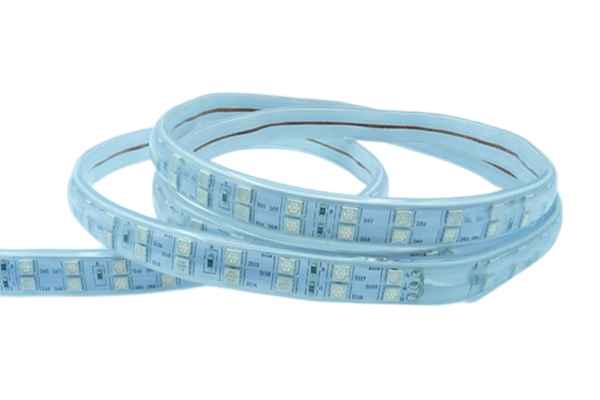What unique design allows high-voltage light strips to easily handle long-distance lighting without degradation?
Release Time : 2025-10-28
In modern lighting projects, LED light strips, due to their flexibility, ease of installation, and high light efficiency, are widely used for architectural contour lighting, commercial space decoration, exhibition hall ambiance creation, and linear lighting applications such as corridors and tunnels. However, traditional low-voltage LED light strips often face a critical problem when deployed over long distances: voltage droop. As the line lengthens, resistance causes the voltage to gradually drop, resulting in noticeable dimming at the end of the light strip, or even a "bright-on, then off" phenomenon, seriously affecting the lighting effect and aesthetics. The emergence of high-voltage light strips fundamentally solves this problem, making them an ideal choice for long-distance continuous lighting. This is due to a series of ingenious and special designs.
1. High-voltage power supply reduces current and reduces line losses
Voltage droop is essentially the voltage drop caused by wire resistance. For the same power transmission, higher voltage requires less current. High-voltage light strips directly connect to 220V AC mains power and operate at extremely low current. Compared to a 12V strip of the same power, the current draw is several amperes. According to Joule's law, line losses are proportional to the square of the current. Therefore, due to the extremely low current draw, even with long lines, high-voltage light strips experience minimal energy loss and voltage drop. This effectively prevents dimming at the ends and ensures highly uniform brightness across the entire strip.
2. Built-in constant-current driver for stable light output
High-voltage light strips do not simply connect LEDs directly to a 220V supply; instead, they incorporate a sophisticated constant-current driver circuit. Typically, a light strip contains a miniature constant-current IC or a resistor-capacitor voltage-stepping and voltage-stabilizing module at regular intervals. These circuits convert high-voltage AC power into low-voltage DC power suitable for LED operation and maintain a constant output current. Even if the input voltage fluctuates within a certain range, the constant-current circuit ensures that each LED group receives a stable driving current, maintaining consistent brightness and color temperature, and eliminating flicker or light decay caused by voltage fluctuations.
3. Modular Design, Supporting Ultra-Long Series Connections
Thanks to its low current and built-in driver, high-voltage light strips can achieve a single-circuit maximum connection length far exceeding that of low-voltage light strips. Low-voltage 12V light strips are generally recommended to be no longer than 5-10 meters, otherwise they must be powered in sections. However, high-voltage light strips can easily achieve continuous series connections of 50, 100, or even longer without the need for intermediate power supplies or amplifiers. This modular design greatly simplifies long-distance wiring projects, reducing the number of power supplies, connectors, and construction costs, making it particularly suitable for large-scale lighting projects such as building facades, bridges, and tunnels.
4. Optimized Circuit Layout, Improved Safety and Reliability
high-voltage light strips Although operating at 220V, these strips utilize a scientific circuit design to ensure safe operation. The LEDs are isolated from the high-voltage circuitry by insulating material. The entire strip utilizes a high-voltage, flame-retardant PCB and is covered with silicone tubing. This provides excellent insulation and protection, effectively resisting dust and water, making it suitable for a variety of indoor and outdoor environments. Furthermore, light strips typically utilize a parallel or segmented independent power supply topology. Even if a single segment fails, it will not affect the operation of the entire circuit, improving system stability and maintainability.
5. Efficient heat dissipation and durable materials ensure long lifespan
Long-distance operation places higher demands on the heat dissipation and material durability of light strips. High-voltage light strips often utilize a metal substrate as a carrier, offering excellent thermal conductivity. This allows them to quickly transfer heat generated by the LEDs to the external environment, preventing accelerated light degradation due to overheating. The highly transparent, UV-resistant silicone coating not only protects the internal circuitry but also resists UV aging, high-temperature deformation, and chemical corrosion, ensuring a service life of over ten years in harsh outdoor environments.
6. Easy installation and reduced overall costs
high-voltage light strips Strips are typically customizable. During installation, simply connecting one end to a 220V power source illuminates the entire strip, simplifying wiring and reducing labor. While the price per strip may be slightly higher than low-voltage strips, the elimination of multiple power supplies, controllers, and complex segmented wiring results in lower overall system and maintenance costs.
In summary, high-voltage light strips, with their high-voltage, low-current power supply principle, built-in constant-current drive technology, modular long-distance series connection capability, safe and reliable circuit design, and excellent heat dissipation and protection, successfully address the challenge of brightness degradation in long-distance lighting installations. This represents not only a technological breakthrough but also a dual improvement in lighting engineering efficiency and aesthetics, providing the ultimate solution for efficient, stable, and aesthetically pleasing linear lighting in modern cities and buildings.
1. High-voltage power supply reduces current and reduces line losses
Voltage droop is essentially the voltage drop caused by wire resistance. For the same power transmission, higher voltage requires less current. High-voltage light strips directly connect to 220V AC mains power and operate at extremely low current. Compared to a 12V strip of the same power, the current draw is several amperes. According to Joule's law, line losses are proportional to the square of the current. Therefore, due to the extremely low current draw, even with long lines, high-voltage light strips experience minimal energy loss and voltage drop. This effectively prevents dimming at the ends and ensures highly uniform brightness across the entire strip.
2. Built-in constant-current driver for stable light output
High-voltage light strips do not simply connect LEDs directly to a 220V supply; instead, they incorporate a sophisticated constant-current driver circuit. Typically, a light strip contains a miniature constant-current IC or a resistor-capacitor voltage-stepping and voltage-stabilizing module at regular intervals. These circuits convert high-voltage AC power into low-voltage DC power suitable for LED operation and maintain a constant output current. Even if the input voltage fluctuates within a certain range, the constant-current circuit ensures that each LED group receives a stable driving current, maintaining consistent brightness and color temperature, and eliminating flicker or light decay caused by voltage fluctuations.
3. Modular Design, Supporting Ultra-Long Series Connections
Thanks to its low current and built-in driver, high-voltage light strips can achieve a single-circuit maximum connection length far exceeding that of low-voltage light strips. Low-voltage 12V light strips are generally recommended to be no longer than 5-10 meters, otherwise they must be powered in sections. However, high-voltage light strips can easily achieve continuous series connections of 50, 100, or even longer without the need for intermediate power supplies or amplifiers. This modular design greatly simplifies long-distance wiring projects, reducing the number of power supplies, connectors, and construction costs, making it particularly suitable for large-scale lighting projects such as building facades, bridges, and tunnels.
4. Optimized Circuit Layout, Improved Safety and Reliability
high-voltage light strips Although operating at 220V, these strips utilize a scientific circuit design to ensure safe operation. The LEDs are isolated from the high-voltage circuitry by insulating material. The entire strip utilizes a high-voltage, flame-retardant PCB and is covered with silicone tubing. This provides excellent insulation and protection, effectively resisting dust and water, making it suitable for a variety of indoor and outdoor environments. Furthermore, light strips typically utilize a parallel or segmented independent power supply topology. Even if a single segment fails, it will not affect the operation of the entire circuit, improving system stability and maintainability.
5. Efficient heat dissipation and durable materials ensure long lifespan
Long-distance operation places higher demands on the heat dissipation and material durability of light strips. High-voltage light strips often utilize a metal substrate as a carrier, offering excellent thermal conductivity. This allows them to quickly transfer heat generated by the LEDs to the external environment, preventing accelerated light degradation due to overheating. The highly transparent, UV-resistant silicone coating not only protects the internal circuitry but also resists UV aging, high-temperature deformation, and chemical corrosion, ensuring a service life of over ten years in harsh outdoor environments.
6. Easy installation and reduced overall costs
high-voltage light strips Strips are typically customizable. During installation, simply connecting one end to a 220V power source illuminates the entire strip, simplifying wiring and reducing labor. While the price per strip may be slightly higher than low-voltage strips, the elimination of multiple power supplies, controllers, and complex segmented wiring results in lower overall system and maintenance costs.
In summary, high-voltage light strips, with their high-voltage, low-current power supply principle, built-in constant-current drive technology, modular long-distance series connection capability, safe and reliable circuit design, and excellent heat dissipation and protection, successfully address the challenge of brightness degradation in long-distance lighting installations. This represents not only a technological breakthrough but also a dual improvement in lighting engineering efficiency and aesthetics, providing the ultimate solution for efficient, stable, and aesthetically pleasing linear lighting in modern cities and buildings.







